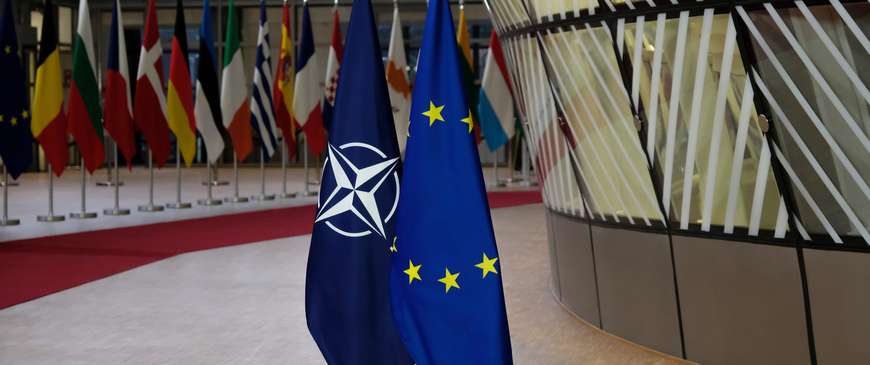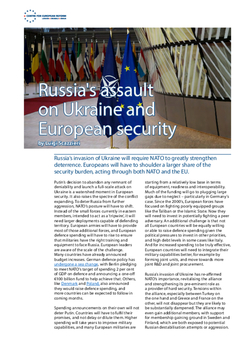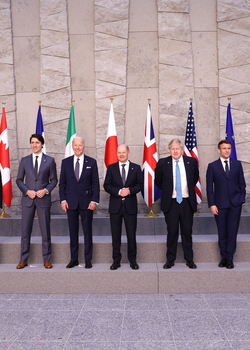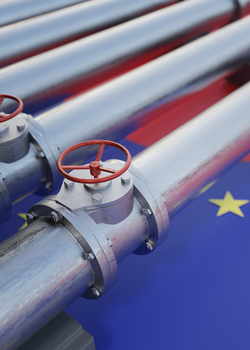
Russia's assault on Ukraine and European security
Russia’s invasion of Ukraine will require NATO to greatly strengthen deterrence. Europeans will have to shoulder a larger share of the security burden, acting through both NATO and the EU.
Putin’s decision to abandon any remnant of deniability and launch a full-scale attack on Ukraine is a watershed moment in European security. It also raises the spectre of the conflict expanding. To deter Russia from further aggression, NATO’s posture will have to shift. Instead of the small forces currently in eastern members, intended to act as a ‘tripwire’, it will need larger deployments capable of defending territory. European armies will have to provide most of those additional forces, and European defence spending will have to rise to ensure that militaries have the right training and equipment to face Russia. European leaders are aware of the scale of the challenge. Many countries have already announced budget increases. German defence policy has undergone a sea change, with Berlin pledging to meet NATO’s target of spending 2 per cent of GDP on defence and announcing a one-off €100 billion fund to help achieve that. Others, like Denmark and Poland, also announced they would raise defence spending, and more countries can be expected to follow in coming months.
Announcements of additional defence spending won't deter Putin. Countries will have to fulfil their promises, and not delay or dilute them. And higher spending will take years to improve capabilities.
Spending announcements on their own will not deter Putin. Countries will have to fulfil their promises, and not delay or dilute them. Higher spending will take years to improve military capabilities, and many European militaries are starting from a relatively low base in terms of equipment, readiness and interoperability. Much of the funding will go to plugging large gaps due to neglect – particularly in Germany’s case. Since the 2000’s, European forces have focused on fighting poorly equipped groups like the Taliban or the Islamic State. Now they will need to invest in potentially fighting a peer adversary. An additional challenge is that not all European countries will be equally willing or able to raise defence spending given the political pressures to invest in other priorities, and high debt levels in some cases like Italy. And for increased spending to be truly effective, European countries will need to integrate their military capabilities better, for example by forming joint units, and move towards more joint R&D and joint procurement.
Russia’s invasion of Ukraine has re-affirmed NATO’s importance, revitalising the alliance and strengthening its pre-eminent role as a provider of hard security. Tensions within the alliance, especially between Turkey on the one hand and Greece and France on the other, will not disappear but they are likely to be substantially dampened. The alliance may even gain additional members, with support for membership gaining ground in Sweden and Finland, which are both exposed to potential Russian destabilisation attempts or aggression. Even if they do not end up joining, their co-operation with NATO will deepen.
While the conflict has revived NATO, it has also shown the EU’s critical role in facing the challenge. It was through the EU that member-states imposed sweeping sanctions on Russia. In an unprecedented step, the EU will provide Ukraine with €1 billion in military assistance. The EU’s importance will only grow in the coming months as it tries to mitigate the war’s economic and social spill-over effects on the Union. In the defence field, the effectiveness of the EU’s military support for Ukraine remains to be seen. But the EU’s policy choices will determine whether higher defence spending across Europe can be reached and sustained. Member-states could for instance agree to relax EU fiscal rules regarding defence spending, allowing more countries to quickly invest money in new equipment and improving the readiness of their forces. Member-states could agree to inject more money into the European Defence Fund, which is designed to foster more co-operation in researching and developing military capabilities. And the EU could also agree to issue new collective debt to finance co-operative defence spending. Failure to agree on sizeable financing mechanisms would hobble European security at a critical time.
Putin’s attack on Ukraine should ideally put the divisive debate about European ‘strategic autonomy’ to one side and act as a catalyst for a new era of security co-operation between the EU and NATO, and between EU and non-EU NATO allies. But that is not certain to happen. The divisions on strategic autonomy could endure. Despite NATO’s revival, concerns about the US commitment to Europe’s defence under a Trump-like president will not disappear. The conflict has again shown the degree of European reliance on the US. This will provide arguments to those EU countries, like France, that want to strengthen the EU as a defence actor as an insurance policy against a possible US disengagement from Europe. But the idea of a larger military (as opposed to security) role for the EU, for example setting up a fully-fledged EU military headquarters able to run large operations, is controversial, since it would entail a degree of duplication with NATO and potentially divert resources from it. At the same time, although there has been much closer dialogue between the EU and NATO in recent years and especially since Russia’s invasion, there are still obstacles to greater formal co-operation. Turkey is vetoing formal NATO co-operation with the EU and Cyprus is doing the same within the EU, and neither shows signs of dropping their opposition.
Nevertheless, even if more formal EU-NATO co-operation proves unreachable, an informal division of labour is likely to develop. NATO will lead on deterrence and defence, while the EU will lead on those elements of security where there is a strong economic or regulatory dimension, the so-called ‘resilience’ agenda. And the EU has a crucial role to play in enabling greater defence spending and joint procurement through expanded funding and fiscal incentives. Some overlap and duplication will probably be inevitable, but there may be no alternative to strengthening European security and insuring against US retrenchment.
Putin’s invasion of Ukraine will force NATO to focus on the threat of Russian aggression. But security challenges in other parts of Europe’s neighbourhood have not disappeared.
Putin’s invasion of Ukraine will force NATO to focus on the threat of Russian aggression. But security challenges in other parts of Europe’s neighbourhood have not disappeared. Many will be exacerbated by the conflict: for example, many countries in the Middle East and Africa depend heavily on food exports from Ukraine or Russia. Food insecurity will contribute to social unrest and instability. Terrorist groups continue to pose a threat, not only in the MENA but also in the Sahel region. Reducing dependence on Russian energy will mean increased reliance on MENA suppliers like Qatar and Algeria. And, even if the nuclear deal with Iran is revived, Tehran’s disruptive foreign policy could continue to undermine regional stability. In the Balkans, Russia will continue to foster instability, especially by backing Milorad Dodik, the leader of the Bosnian Serbs, in his attempts to secede from Bosnia. With NATO and the US focused on deterrence, it will fall primarily on the EU to deal with these challenges, through diplomacy, trade, aid, and military assistance. But flexible groups of member-states, the so-called ‘coalitions of the willing’, are also likely to play a role when the EU as a whole is unable to act.
Putin’s invasion of Ukraine marks the start of a more dangerous era for European security. European leaders must rise to the challenge, overcoming their divisions and strengthening their defences, both through the EU and NATO.
Luigi Scazzieri is a senior research fellow at the Centre for European Reform.



